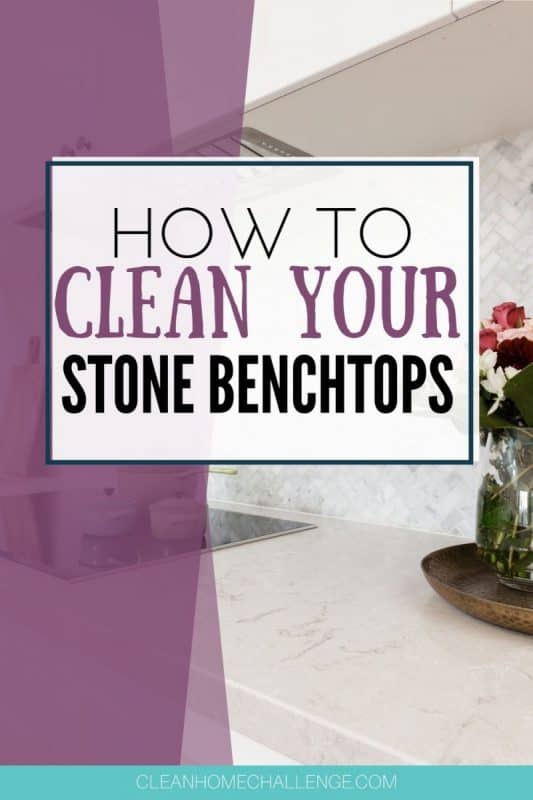THIS POST MAY CONTAIN AFFILIATE LINKS. PLEASE READ MY DISCLOSURE FOR MORE INFO.
Whether in our kitchen, studios, or workplaces, we all like spotless benchtops. Since we’ll be seeing a lot of them, we’d like to make sure that they’re a treat on the eyes and up to muster.
4 Easy Steps To Clean Your Stone Benchtops
- Clean up spills immediately to avoid staining
- Use paper towel to soak up liquid spills
- Use warm soapy water on a microfibre cloth to clean up the spill
- Use a clean microfibre cloth to dry and buff up your stone benchtop
Unfortunately, stone benchtops also just happen to be magnets for stains that just don’t want to let go and other such pesky marks. After all, they’re subject to grubby fingers, potent ingredients, and abrasive materials all the livelong day.
It is up to us to be the brave guard that stands between our pristine stone benchtops and a world of dirt. Here’s how:
Determining your benchtop’s susceptibility to staining.
Whether your benchtop is a matte, honed, textured, or non-gloss surface, it’s just as durable as gloss surfaces. What really matters is how porous or non-porous its material is.
Most non-glossed or marble-like surfaces are highly porous, meaning that they’ll need that bit more attention. Materials tend to seep into their pores and get comfortable.
Concerning glossed or shined surfaces, their pores are smaller (could be almost non-existent), so they manage to keep everything above-board.
How To Keep Your Stone Benchtop Clean
Either way, treating your benchtop to one wipe down a day with a clean cloth and soapy water is a must, even if you haven’t used the surface. Make that two wipe downs for porous benchtops. If you’d like to be extra thorough, try a mild, bleach-free, non-abrasive detergent to wipe away any potentially harmful substances.
Be Mindful Of What’s In Your Cleaners
Be wary of what you clean your surfaces with. Some surface cleaners contain ingredients that could damage your engineered stone or diminish the polished surface over time, and that’s the last thing you want.
So, think twice before subjecting your precious benchtops to bleach, oil-based soaps, nail varnish removers, or furniture cleaners. Anything stronger is a sure no-no.
Now to find out what materials need extra care:
- Turmeric
- Beetroot
- Red Wine
- Oils
- Berries
- Fruit & Vegetable Juices
- Pasta Sauce
And the list goes one. As you’ve probably noticed, these are colorful and potent substances. So, always handle these benchtop-unfriendly materials with care.
If A Spill Does Happen
But since we live in reality, things are going to spill, and spice jars will fall over. No need to panic; stay cool, calm, and collected and try the following:
- Soak up spills immediately with a paper towel
- Reach for a clean cloth as oils from a dishcloth can cause further damage.
- Use a non-abrasive soapy liquid to dampen the cloth.
- Using swirling motions and steady pressure, wipe over the surface of the stain. Be patient. This allows the cloth and soap particles to work away at the stain, which can take some time.
- Dry down the surface using a paper towel to ensure there’s no lasting stain and that the benchtop remains scuff-free.
How To Avoid Any Impacted Stains
- Keep a spill mat under any metal containers to avoid rusted marks.
- Have heat mats on hand to place under pans/pots
In short, it’s best to follow your usual clean-up routine. Don’t bring out the big-boy cleaners or techniques until you’re sure the stain is putting up a fight.
But What If There’s Already A Stain?
Again, no need to panic. It’s only a matter of knowing how to get rid of it.
- Firstly, use a plastic spatula to gently rub the surface of the stain. This is to remove the top layer that can solidify the material in place. Think of it like unclogging pores.
- Avoid using harsh or abrasive materials such as steel wool or a tough sponge.
- On a non-porous bench, use a small amount of white cream paste on a very wet cloth, then wipe down liberally and let it sit to soak in.
- On a porous bench, it’s best to contact the benchtop manufacturers before using any cleaning chemicals. However, once the top layer is removed, trying soapy water on a clean cloth could turn up promising results.
Can I Use Vinegar To Clean My Stone Benchtops
If you are looking to use a natural cleaner on your stone benchtops, then a 50/50 mixture of vinegar and water is all you need.
Make it up and place into a spray bottle.
If you’re feeling extra fancy once you’re done, consider giving your benchtop a quick wipe down with a splash of methylated spirits on a clean cloth. This rids the surface of any eyesore dried marks and scuffs leftover from scrubbing.
And finally, stand back and take a look at your good work. Your benchtops have survived another day spot-free, and since you’re now equipped with the knowledge to keep them that way – may they stay that way forever!









